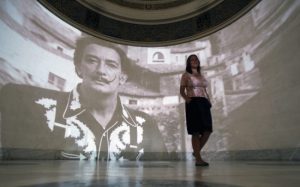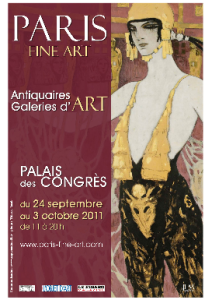1. Wanted: a keeper for a hidden gem.
Ask for a museum in Barcelona, and everybody will say Museu Picasso, whose collection of youthful works, examples of the Menina’s series from the fifties and other pockets of the master’s oeuvre attract a respectable 1,369,000 visitors (2010’s data from TAN) to its dwellings in the Gothic Quartier. But there is yet another jewel in the city, placed at the top of Montjuïc hill overseeing the urban grid and the sea: the Museu Nacional d’Art de Catalunya (National Gallery of Catalonia), that claims to show “1,000 years of Catalan Art” and actually houses one of the finest Romanesque collections in the world. The Museu is now searching for a new director. The open contest was launched last Monday 19th September, and deadline for applications is next October 30, 2011. The outlines state as key requirement to come up with “a clear vision of what the situation of the MNAC should be in all areas of its activity, both at the national and international level”, and the deal will be for five years. Other details, including the composition of the deciding committee, can be found in the MNAC’s website.
2. Dalí’s hype in Moscow.
Ask again for a museum, but in Catalonia, and the most likely answer will be Fundació Gala-Salvador Galí. The numbers there are 1,330,000 visitors (2010’s official data) in its three sites in North Catalonia, headed by the Teatre–Museum in Figueres (a derelict theatre turned in to a “surrealistic object” under Dali’s design). A good 130,000 of these museums-goers come from Russia and this is one of the reasons that has pushed the Fundació to have a show in the Puskhin Museum in Moscow (“Salvador Dalí: a retrospective”, from September 3rd to November 13th.) The generous selection of works, a strong presence of Gala (Dalí’s Russian partner), the dramatic set by painter and Bolshoi’s stage-designer Boris Messerer and of course, the Dalí name’s allure had lead to a resounding success in the numbers side.
3. And Russia in the Prado.
In another development of this 2011 Dual Year Spain – Russia, the Hermitage will land in the Museo del Prado next 8th November (“The Hermitage in the Prado”, up to 25th March 2012). ). All the forward notices point out that the Russian Ark will come loaded with treasures of all kinds an ages, from 5th BC archaeology to 20th AD avantgardes. I am sure this old-fashioned, grand mannered encyclopaedic approach will prove irresistible. In fact, curator Dr. Gabrielle Finaldi, the Prado’s normally very focused Director of Research, has already called it “amazing, really amazing”.
4. Napoleonic invaders had good taste.

More on fellow Europeans touring Spain: thanks to an innovative scanning technique, a joint team of Rijksmuseum and the universities of Antwerp and Delft recorded a hidden and previously unknown portrait underneath his “Portrait of Don Ramon Satué”. The work was left unfinished, but it clearly show the sitter wearing a French military uniform completed with the highest decorations of Joseph de Bonaparte’s regime. These were only awarded to the Joseph himself or one of the 15 generals at his service. A full rendering of the findings will be published in the October issue of the Burlington Magazine. This new discovery also points to the interesting subject of leading Spanish artists’ accommodation to the French rule. Even more attractive than Goya’s is Vicente López Portaña’s case, who (in my own personal view) made real progress only when he was working for the new masters. After Napoleon’s brother was ousted from the throne (with some help from Wellington), López became the official portraitist for Fernando VII, the king that in the twisted politics of 19th century Spain, first returned as liberals’ “el Deseado” (“The Wanted”), only to finally call in the French “Saint Louis’ One Thousand Sons” to restore order and Ancient Regime. López’ continuing portraits clearly adapted to the changing political scenarios.
5. Paris’ perennial charm.
Thanks to a “Diaporama” signed by Lucie Agache in the always interesting Conaissance des Arts Newsletter, I come across to yet another Paris fine art fair, plainly called Paris Fine Art and open and open from 24th September to 3rd October. Had I been aware of it with some more time, I would have been really tempted to attend, since it is in these mid-range gatherings where exciting discoveries are waiting to be made. So if you want to have a try, and report back any unexpected treasure, this blog is more than open to your feedback.
6. Make it double.
Involving again the Connaisance des Arts Newsletter and Paris, I learn about the “Fra Angelico et les Maîtres de la Lumière” (“Fra Angelico and the Masters of Light”) exhibition in the Musée Jacquemart André in the French capital. In a model interview in the “Connaissance” website, curator Nicolas Sainte-Fare-Garnot, needs only a little more than seven minutes to broaden the topic on Fra Angelico’s passage from Middles-ages to Early Renaissance, and depict it as a passage from cloisters to city, from word-based preaching to image-based preaching, from flatness to volume and profundity through the play of light and darkness.
7. An Internet classic.
To open this section on features that have lasted more a decade in the online world (which counts as a century in our offline lives), this week we pay our respects to the venerable “Heilbrunn Time Line of Art History”, launched in 2000 in the Metropolitan Museum website. Covering no less than 10,000 years of human history and no shorter than all major cultures from all parts of this world, the TOAH is always a reference when you need the big picture of all that.
Miss anything? Send me your good ideas either as a comment below or by email to jordi@jordidenadal.com.



